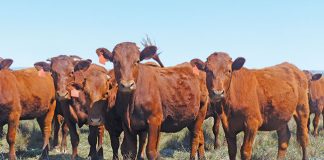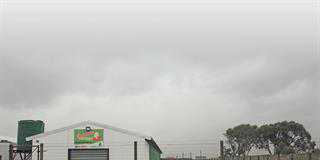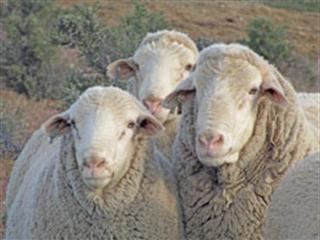
Take a good carcass with lean meat. Add quality Merino-type wool. Mix in exceptional fertility. And finish off with excellent grazing ability. This is a fair description of the Afrino, and if it isn’t a recipe for a successful sheep breed, what is? The Afrino is one of South Africa’s youngest home-bred breeds, and while it may not have had the same impact on the small-stock industry as the famous Dorper, it is a logical option for arid regions, particularly when the wool price is high.
According to Charlotte Milne, secretary of the Afrino Breeders’ Society, an Afrino ewe will produce a lamb even during a severe drought as she can efficiently convert feed into milk. “Fleece quality may suffer under adverse conditions, but you’ll still have a lamb – plus a wool cheque,” she says. Since 2006, this white wool mutton sheep has been part of a long-term national programme to establish a biological reserve for small-stock research and conservation.
Much of the performance data are derived from ongoing studies on the Afrino flock established at Carnarvon experimental station in the Northern Cape in 1969. The research evaluates selection criteria to improve both reproductive efficiency and mutton and wool production of dual purpose sheep breeds under extensive conditions. The station also stores blood samples and extracted DNA samples of all animals studied.
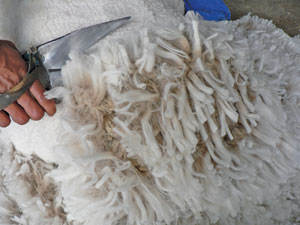
The breed produces wool with a diameter of 19 microns to 22 microns.
“Because the Carnarvon flock has been part of selection trials for such a long time, it’s possible to follow and improve economically important factors such as genetic trends in fibre diameter, weaning weight and lifetime total weight of lamb weaned,” says Dr Gretha Snyman of Grootfontein Agricultural Development Institute, currently in charge of Afrino research.
History of the breed
The Afrino originated during the depressed wool market of the late sixties, when farmers began cross-breeding Merino ewes with mutton breeds. However, these crosses had kemp or coloured fibre, leading to contamination of the South African wool clip. As a result, the wool industry appealed to the Department of Agriculture to develope a white-woolled breed for use as a terminal sire in crosses with Merino ewes.
In addition to being free of kemp and coloured fibre, it also had to be adapted to the harsh, dry conditions of Karoo sheep farms. For this reason, Carnarvon was chosen as the site for a breeding project involving eight different crosses between Merino ewes and several white-woolled and white-haired mutton breeds. The aim was to develop a new, white-woolled mutton sheep that combined the quality wool of the Merino with the reproductive performance and mutton-producing capacity of meat breeds.
By 1976, the optimal cross – 25% Merino, 25% Ronderib Afrikaner and 50% SA Mutton Merino – had been achieved. In addition to producing good results as a terminal sire in crosses with Merino ewes, the Afrino was found to be good enough to stand as a breed in its own right, and the Afrino Sheep Breeders’ Society was established in 1980.
“Today, the society works closely with animal breeding researchers and continues to base its selection on scientific results,” notes Milne. “For example, the Afrino is the first South African sheep breed in which the separation of ram and ewe selection objectives was investigated and applied. Rams are selected on growth and fleece traits, and ewes on reproductive traits.” Gerald van Heerden, well known as a sheep and wool expert while working for BKB, the Wool Board, and the National Wool Growers’ Association, praises the Afrino as a low-input sheep and ideal for extensive farming.
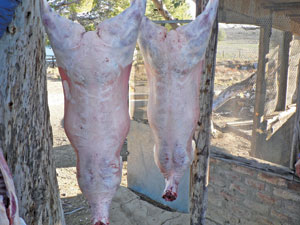
Lean Afrino mutton and lamb carcasses show the lack of unwanted fat. Photos: Roelof Bezuidenhout
“Ewes are wonderful mothers with a long, productive lifespan, and need little attention,” he explains. “Blowfly attacks are minimal. Afrinos are also good for feedlots – they keep growing under high nutritional levels and produce quality lean meat when other breeds or crosses put on fat. And you don’t need to buy feed when conditions are tough. It keeps producing on hard, dry veld.”
Van Heerden particularly approves of the ability of Afrino hamels (wethers) to do well on sour grassveld where it would be too expensive to feed and run ewes. He explains that the breed’s hardiness derives from its Afrikaner background and the fact that breeders do not compete in shows, focusing instead on their national veld ram club. “Look at its conformation,” he says. “Instead of round hindquarters, its legs are long and lean, more like those of an antelope. And they’re under the animal, not alongside it like a 4×4, or some of the mutton breeds today.”
Van Heerden sees the Afrino primarily as a mutton breed. “The wool is a bonus, although recently breeders have paid much attention to improving fleece quality. Afrino wool definitely qualifies as Merino,” he says. George Stegman of Slagterskuil, Willowmore, owner of the A7 Afrino Stud, agrees that Afrino wool matches that of quality Merino fleeces. “But you have to select carefully for good wool traits because you shear only 2,5kg to 3kg per ewe at 12 months,” he says.
Stegman tests the wool of his young ewes and rams annually and this has resulted in a marked improvement. “Rams selected for my own stud have very uniform wool with a high comfort factor,” he explains. “My clip averages between 19 and 21 microns, with clean yield of between 60% and 70%. “Ewes weigh about 60kg, about 10kg more than pure Merinos in my area. And rams are robust.”
Stegman’s father, Fred Stegman, was a founder member of the Afrino Breeders Society. “I remember how excited he was about trying out the new breed back in the seventies,” Stegman recalls. “I think he had reason to be because the breed has proved itself when the going gets tough. During the severe ’91 and ’92 drought, I still managed to get 80% to 90% lambing on the veld.”
Stegman admires the breed’s adaptability, grazing habits, and walking ability.
“It utilises veld superbly and is arguably king of the mountains,” he says. “I also like the way old ewes hold their condition. You never struggle to market them.” He believes that for selection to remain income-driven, the focus should be on production and reproduction under the harsh, extensive conditions of the Karoo. “Ewes that produce good quality lambs under these conditions must remain a priority. I feel Afrino breeders have succeeded in this respect.”
Afrino breed standards – a few pointers & qualities
General
- Selection of breeding sires and dams should take place under the same conditions as those in which their offspring have to breed.
- The main selection objective is to increase the lifetime weight of lamb produced per ewe.
Meat
- High quality meat with an even fat distribution.
- Lambs must not accumulate fat too early so that animals can be marketed at a later age and higher body weight.
- Average marketing age is 7 to 8 months under extensive conditions. Under feedlot or favourable conditions, lambs should reach marketing weight as early as 3 months.
Wool
- Wool should make up only 3% to 4% of body weight.
- The Afrino produces Merino-type wool, with a fibre diameter of 19 to 22 microns.
- During selection, emphasis is placed on wool quality – fibre diameter, crimp definition and clean yield.
- Ideal length is B to A length (60mm to 80mm) over 12 months’ growth.
- The body and belly of the Afrino must be covered with a fair amount of good quality wool. However, as this is a dual purpose breed, the amount will depend on conditions. Clean bellies will be seen in ewes that have suckled lambs and also on some rams.
- Afrino wool should have a fibre diameter of not more than 23 microns. It must be free of kemp, with as little variation as possible. Yellow or a chalky white fleeces are not acceptable.
Conformation Head
- This should be big, open and with a strong, defined appearance. The upper and lower jaw should be well developed, with prominent nostrils.
- Ewes are polled. In the case of rams, a scur (small loose horn) is allowed.
- The face must be covered with soft, cream-coloured hair without any kemp.
- A small tuft of wool is allowed on the forehead, but there should be no wool on the cheeks.
Hindquarters
- The hindquarters must be wide across the hips and pin bones. There should be good blending at the barrel.
- Inner and outer thighs must be muscular and well-fleshed.
- A somewhat drooping rump is preferable.
The Carnarvon flock
The Afrino flock at the Carnarvon experimental station – where rain seldom tops 200mm a year – consists of 200 breeding ewes.
“Performance testing has made it possible to genetically increase body weight and lifetime total weight of lamb weaned, while simultaneously decreasing fibre diameter,” says Dr Gretha Snyman of Grootfontein Agricultural Development Institute. “Since 1991, all selection in this flock has been based on BLUP breeding values for the specific traits under selection.”
Reference: www.afrino.co.za
Contact George Stegman on 044 934 1135
Email Charlotte Milne on [email protected]











